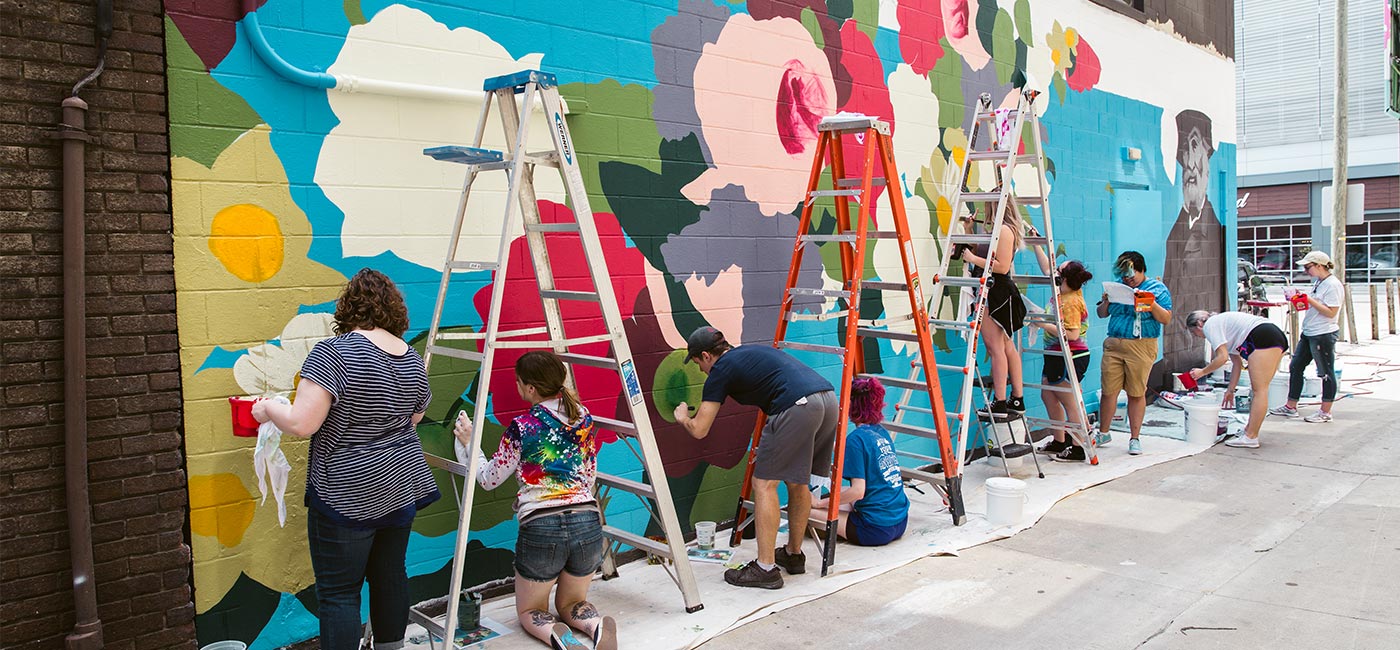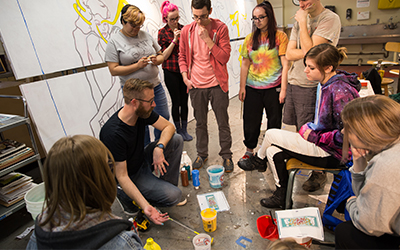Another brick in the wall
Parsley’s work gives art students the big picture on making their passion a profession.

Getting a job in art need not seem like hitting a brick wall, Art Department Chair and associate professor Tim Parsley tells his students. They just need to find a window of opportunity in that wall.
Arriving in Fort Wayne five years ago, with a Cincinnati murals background and a chance to impart his art and work experience to USF students, he paints a picture as big as a city block on how to make one’s passion into a job.
“I am deeply committed to helping students figure out how making art can be sustainable as a career. My class is about equipping them for the business of art. A benefit for the students is to know their artist professor is out doing this. He’s in the same trench as them. They can find their passion, stick to it and make it work.”
When he got to Fort Wayne, people kept asking about mural work. “We always needed funding,” he said. “We needed a fiscal partner in the Downtown Improvement District (DID).” Then Art This Way conceived the Alley Activation Project, and the DID, Fort Wayne Chamber of Commerce Foundation, Lincoln Financial Foundation and Design Collaborative became sponsors. Three artists city-wide were selected to produce public art works downtown. One of them was Parsley and USF.
Artist Alexandra Hall had been doing local events, and was called to help. “She met up with School of Creative Arts (SOCA) Dean Colleen Huddleson and me,” Parsley said. “She had the building owners lined up and a funding model since last summer. I was able to provide additional guidance through the planning stages, and I could help with the jury process. I suggested that we combine this opportunity with a course we had been dreaming of at SOCA so that students could learn the nuts and bolts of creating a public mural.”
Though Parsley created the mural design, the students contributed hands-on work at the downtown site and learned about the nature and meaning of public art, and the business of art, in Parsley’s class.
“I was to design it and use it to help USF students learn the mural process from beginning to end,” he said. “Downtown, they helped clean and transform the wall and its color. In class, we talked about mural painting and public art, about surveying the public’s interests and engaging the community. I assigned a portable, in-house ‘practice mural’ that was student-designed, selected and created, which is now on display in SOCA. They also had to learn contracts, so we got into the fine print about how to get paid and protect their work.”
The downtown mural’s theme draws from American history, which informs Parsley’s work as an artist. “It’s based on a collage I made previously. It’s about the greatness, the complication and the challenges of American history. Walt Whitman is present as a figurehead artist at a divided time. He spoke his time, and artists today can do the same. We also live in a divided time. Whitman represents what the artist can offer. In divided times, art can offer beauty, confrontation or maybe just a different perspective,” he said.
Such artwork should be arresting, he said. “For me, public art should engage you in aesthetic contemplation. Stop a moment. Let it inspire awe or raise new questions. It’s important for USF to be involved with this because the students begin to understand how their artistic passion can be a profession and a chance to serve the community. Let’s bring it to our neighborhoods. Interact with our world. With public art, it’s not just funding, it’s neighbors who walk by and stop and talk. It’s a neighborhood relationship.”
Understanding how to structure a professional life makes working in their passions possible for students. “It may not always look like a typical 9-to-5 job, but sustaining a career as an artist is entirely possible. They must stay passionate, trust it and pursue it—hard work will be rewarded,” he said.
I am deeply committed to helping students figure out how making art can be sustainable as a career.
– Tim Parsley, Art Department Chair and associate professor